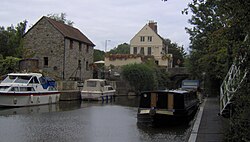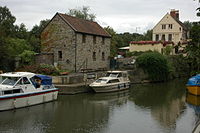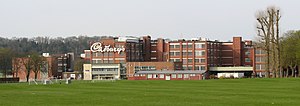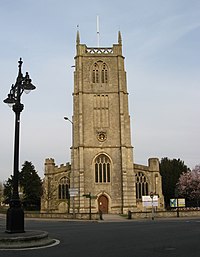Keynsham
| Keynsham | |
| Somerset | |
|---|---|
 Keynsham Lock | |
| Location | |
| Grid reference: | ST654684 |
| Location: | 51°24’49"N, 2°29’48"W |
| Data | |
| Population: | 15,533 (2001) |
| Post town: | Bristol |
| Postcode: | BS31 |
| Dialling code: | 0117 |
| Local Government | |
| Council: | Bath & NE Somerset |
| Parliamentary constituency: |
North East Somerset |
Keynsham is a town in Somerset, found between Bristol and Bath. It had a population of 15,533 in 2001. It gives its name to the Keynsham Hundred of Somerset.
The town was listed in the Domesday Book as Cainesham, and the name is believed to come from that of Saint Keyne; "Keyne’s home".
The site of the town has been occupied since prehistoric times and is scattered with Roman remains. It became a mediæval market town, after Keynsham Abbey was founded around 1170. It is situated at the junction of confluence of the River Chew and River Avon and was subject to serious flooding before the creation of Chew Valley Lake and river level controls at Keynsham Lock. The Great Flood of 1968 inundated large parts of the town. It was home to the Cadbury's chocolate factory, Somerdale, which opened in 1935 as a major employer in the town.
It is home to Memorial Park, which is used for the annual town festival and several nature reserves. The town is served by Keynsham railway station on the London-Bristol and Bristol-Southampton trunk routes and is close to the A4 road which bypassed the town in 1964. There are schools, religious sporting and cultural clubs and venues.
Geography
Keynsham stands where the River Chew meets the River Avon.
Fishing rights for the Millground and Chewton sections of the Chew are owned by Keynsham Angling Club. The Mill Ground stretch of the River Chew consists of the six fields on the western bank from Chewton Place at Chewton Keynsham to the Albert Mill. The water is home to chub, roach, perch and rudd, along with good numbers of gudgeon, dace and trout.[1] Keynsham Lock on the Avon opened in 1727.[2] Just above the lock are some visitor moorings and a pub, on an island between the lock and the weir. The weir side of the island is also the mouth of the River Chew.
Memorial Park, the northern part of which has existed as parkland since the 19th century,[3] as shown by the Ordnance Survey maps of 1864 and 1867,[4] was formally laid out after Second World War was extended after the floods of 1968.[5] It covers 26.4 acres of woodland and grass alongside the River Chew. It commemorates the war dead of Keynsham and includes facilities including two children's play areas, a skateboard park, multi-sport area, bowling green, public toilets, a bandstand and refreshment kiosk. The formal gardens within the park are adjacent to the River Chew with the Dapps Hill Woods at its western end.[3] Part of the park is known locally as Chew Park because of its proximity to the River and another area, close to Keynsham Abbey as Abbey Park.[6] The park received the Green Flag Award in 2008/09, and again for 2009/10.[6]
On the outskirts of Keynsham lies Keynsham Humpy Tumps, one of the most floristically rich acidic grassland sites in the area. The site is on a south-facing slope running alongside the Bristol to Bath railway line. It consists of open patches of grassland and bare rock, interspersed with blocks of scrub. The site does not have any statutory conservation status, and is not managed for its biodiversity interest. Threats to its ecological value include the encroachment of scrub onto the grassland areas, and damage from motorcycle scrambling.
Between Keynsham and Saltford, a 37.1-acre (15.0-ha) area of green belt has been planted, with over 19,000 trees,[7] as the Manor Road Community Woodland, which has been designated as a Nature Reserve.[8] Nearby is the Avon Valley Country Park tourist attraction.
History
Evidence of occupation dates back to prehistoric times, and the town site is scattered with Roman remains, such as the Roman villas at Somerdale which were discovered during the construction of the factory there in 1922, and included the discovery of two stone coffins. Also a villa with nine intact panels of mosaic flooring has been found at Durley Hill and a burial site between Keynsham and Saltford.[9]
Keynsham is listed in the Domesday Book of 1086 as Cainesham, meaning St Keyne's home, possibly the dedication of a church or monastic community. It is believed that Saint Keyne lived in the 5th century, the daughter of Brychan.[10] According to local legend, St Keyne was warned by the local King that the marshy area was swarming with snakes, which prevented habitation, so St Keyne prayed to the heavens and turned the snakes to stone.[11] The fossil ammonites found in the area were believed to be the result.[12]
The settlement developed into a mediæval market town, its growth prompted by the foundation of the influential and prosperous Keynsham Abbey, which had been founded by the Victorine congregation of canon regulars around 1170. It survived until the dissolution of the monasteries in 1539, and a house was subsequently built on the site. The remains have been designated as a Grade I listed building by English Heritage.[13]
Keynsham played a part in the Civil War as the Roundheads saved the town and also camped there for the night, using the pub now known as the Lock Keeper Inn as a guard post.[14] During the Monmouth Rebellion of 1685 the town was the site of a battle between royalist forces and the rebel Duke of Monmouth.[14]
Before the creation of Chew Valley Lake and river level controls at Keynsham Lock and weir, Keynsham was prone to flooding. The Great Flood of 1968 inundated large parts of the town, destroying the town's bridges including the county bridge over the Avon which had stood since mediæval times, and private premises on Dapps Hill; the devastation was viewed by the Duke of Edinburgh.[15] After the flood the Memorial Park, which had been laid out after Second World War was extended.[5]
Keynsham had brief fame in the mid-1960s after featuring in a long-running series of advertisements on Radio Luxembourg for Horace Batchelor's Infra-draw betting system. To obtain the system, listeners had to write to Batchelor's Keynsham post office box, and Keynsham was always painstakingly spelled out on-air, with Batchelor famously intoning "Keynsham – spelt K-E-Y-N-S-H-A-M – Keynsham, Bristol".[16]
Since the 1950s Keynsham has become a dormitory town for Bristol and Bath. The High Street shopping area has been remodelled, and a Town Hall, Library, and Clock Tower were built in the early 1970s.[17]
Economy
An important industry in the town was Cadbury's chocolate factory, the Somerdale Factory. The J. S. Fry & Sons business merged with Cadbury in 1919, and moved their factory in the centre of Bristol to Keynsham in 1935.[18] As Quakers, the factory was built in a 228-acre greenfield site with social facilities, including playing fields and recreational sports grounds. Called Somerdale after a national competition in 1923, Keynsham Cadbury is the home of Fry's Chocolate Cream, the Double Decker, Dairy Milk and Mini Eggs, Cadbury's Fudge, Chomp and Crunchie.[19]
On 3 October 2007, Cadbury announced plans to close the Somerdale plant by 2010 with the loss of some 500 jobs and production moved to factories in Birmingham and Poland. In late 2007 campaigns to save the Cadbury's factory in Somerdale were in full swing. One local resident started a campaign to urge English Heritage to protect the site, and preserve the history of the factory. The campaign did not succeed and the site closed.
Before their takeover of Cadbury in February 2010, Kraft Foods had pledged to keep the Cadbury factory at Somerdale open if they were successful in their bid for the company.[20] However, within a week of completing their purchase of Cadbury, Kraft CEO Irene Rosenfeld released a statement announcing that Kraft were to close the factory by 2011, as originally planned by Cadbury. The stated reason for this was that it was only after the purchase had been made that Kraft realised how advanced Cadbury's plans were.[21] Industry experts have however questioned this explanation, arguing that Kraft invested so much in researching their bid for Cadbury that they should have been aware of the extent to which plans had been advanced.[22]
Culture
Keynsham Festival started in the late 1990s.[23] It takes place in the Memorial Park each July,[24] and attracts around 16,000 people.[25] There is also a Victorian evening held in the town each November.[26] Keynsham and Saltford local history society was formed in 1965 and is concerned with researching and recording the history of the area.[27]
Churches
The parish church of St John the Baptist was begun in 1292 and gradually evolved until taking its present general form during the reign of Charles II, after the tower collapsed into the building during a storm in 1632.[28] The tower, built over the north-east corner of the nave, now rises in three stages over the Western entrance and is surmounted by a pierced parapet and short croketted pinnacles and is said to have been built from the ruins of the abbey church. The south aisle and south porch date from 1390. The chancel, then the responsibility of the abbey, was rebuilt in 1470 and further restoration was carried out in 1634–1655, following the collapse of the tower. There is a pulpit dating from 1634 and is also a screen of the same age which shuts off the choir vestry. It has been designated as a Grade II* listed building.[28]
A former organ is said to have stood in the church, but "had tones so mellow" that Handel bargained for it, offering a peal of bells in exchange.[29] The offer was accepted. The musician went off with the organ and the bells were delivered. There are eight bells in total, some made by the Bilbie family of Chew Stoke,[30] the smallest bears these lines:[30]
"I value not who doth me see
For Thomas Bilbie casted me;
Althow my sound it is but small
I can be heard amongst you all."
Churches in the town include:
- Church of England: St John The Baptist (above)
- Methodist:
- Victoria Methodist Church
- Queens Road Methodist Church
Sport
- Cricket: Keynsham Cricket Club
- Football:
- Keynsham Town FC, founded in 1895
- AFC Keynsham, established in 2008
- Rugby: Keynsham RFC
- Others: Bowls, situated at the Memorial Park
Keynsham leisure centre was built in 1965 by British Gas as a gift to the town. It includes a swimming pool, gymnasium and sauna.[31]
Outside links
| ("Wikimedia Commons" has material about Keynsham) |
- Keynsham Town Council
- 2386 (Keynsham) Sqn Air Training Corps
References
- ↑ "River Chew". Keynsham Angling Club. http://www.keynsham-angling.co.uk/chew.htm. Retrieved 30 April 2010.
- ↑ Allsop, Niall (1987). The Kennet & Avon Canal. Bath: Millstream Book. ISBN 0-948975-15-6.
- ↑ 3.0 3.1 "Keynsham Memorial Park". Green Flag. http://www.keepbritaintidy.org/GreenFlag/GreenFlagAwardSites/SouthWest/Default.aspx?parkID=265. Retrieved 2 September 2010.
- ↑ "Keynsham Park". Keynsham Park. http://www.keynshampark.co.uk/. Retrieved 2 September 2010.
- ↑ 5.0 5.1 "Memorial Park, Keynsham, Keynsham". Parks & Gardens UK. Parks and Gardens Data Services Limited (PGDS). http://www.parksandgardens.ac.uk/component/option,com_parksandgardens/task,site/id,2265/tab,summary/Itemid,/. Retrieved 17 September 2008.
- ↑ 6.0 6.1 "Keynsham Memorial Park". BANES. http://www.bathnes.gov.uk/environmentandplanning/parksandopenspaces/Pages/Keynsham%20Memorial%20Park.aspx. Retrieved 2 September 2010.
- ↑ "Manor Road Community Woodland, Local Nature Reserve, Keynsham". Avon local nature reserves. http://www.avonlocalnaturereserves.org.uk/reserve.asp?id=8. Retrieved 30 April 2010.
- ↑ "Manor Road Community Woodland". Forest of Avon. http://www.forestofavon.org.uk/out-and-about/places-to-visit/manor-road. Retrieved 30 April 2010.
- ↑ "Keynsham Heritage Trust". Keynsham Heritage Trust. http://digitalconservation.org/. Retrieved 25 April 2010.
- ↑ Robinson, Stephen (1992). Somerset Place Names. Wimbourne: The Dovecote Press Ltd. ISBN 1-874336-03-2.
- ↑ "Keynsham". Royal British Legion. http://www.wmciu.co.uk/avon-ciu/Keynsham_Royal_British_Legion.htm. Retrieved 6 June 2012.
- ↑ Readers' Digest (1979) [1977]. Folklore, Myth and Legends of Ancient Britain. London: Readers' Digest. p. 158.
- ↑ National Heritage List 13101122: Keynsham Abbey
- ↑ 14.0 14.1 Clark, Pete. "Keynshams part in the Monmouth Rebellion". Keynsham Community Website. Archived from the original on 5 March 2010. http://web.archive.org/web/20100305123512/http://www.keynsham.co.uk/history/monmouthrebellion.html. Retrieved 30 April 2010.
- ↑ "The day the rains came". Evening Post. 15 July 2008. http://www.thisisbristol.co.uk/news/day-rains-came/article-220159-detail/article.html. Retrieved 13 June 2010.
- ↑ "Doing the Keynsham pools". Bath Chronicle. This is Bath. http://www.thisisbath.co.uk/news/Doing-Keynsham-pools/article-764050-detail/article.html. Retrieved 2 February 2009.
- ↑ "Keynsham in focus". BusinessMatters. Bath and North East Somerset Council. http://www.business-matters.biz/site.aspx?i=pg68. Retrieved 12 May 2011.
- ↑ "Cadbury factories shed 700 jobs". BBC. 3 October 2007. http://news.bbc.co.uk/1/hi/business/7025413.stm. Retrieved 30 April 2010.
- ↑ "Cadbury's Bristol plant to close by 2011". BBC. 9 February 2010. http://news.bbc.co.uk/1/hi/business/8507066.stm. Retrieved 30 April 2010.
- ↑ "Takeover bid". Thompson Reuters. 7 September 2009. http://phx.corporate-ir.net/External.File?item=UGFyZW50SUQ9MTQ1ODZ8Q2 hpbGRJRD0tMXxUeXBlPTM=&t=1. Retrieved 30 April 2010.
- ↑ "Cadbury's Bristol plant to close by 2011". BBC News. 9 February 2010. http://news.bbc.co.uk/1/hi/business/8507066.stm. Retrieved 19 April 2010.
- ↑ "Cadbury factory closure by Kraft 'despicable'". BBC. 10 February 2010. http://news.bbc.co.uk/1/hi/business/8507780.stm. Retrieved 30 April 2010.
- ↑ "Keynsham Music Festival". Visit Bath. http://visitbath.co.uk/site/whats-on/keynsham-music-festival-p373083. Retrieved 2 September 2010.
- ↑ "Keynsham Festival". Keynsham Festival. http://www.keynshammusicfestival.co.uk/. Retrieved 2 September 2010.
- ↑ "Delighted fans say town's music festival hits all the right notes". This is Bath. http://www.thisisbath.co.uk/Delighted-fans-say-town-s-music-festival-hits-right-notes/story-11336646-detail/story.html. Retrieved 6 June 2012.
- ↑ "Keynsham Victorian Evening 2009". Keynsham Town Council. http://www.keynsham-tc.gov.uk/Core/Keynsham-Town-Council/Pages/Victorian_Evening_1.aspx. Retrieved 2 September 2010.
- ↑ "Keynsham & Saltford local history society". Keynsham & Saltford local history society. http://www.keysalthist.org.uk/. Retrieved 30 April 2010.
- ↑ 28.0 28.1 National Heritage List 11614233: Church of St John the Baptist
- ↑ Johnstone, H. Diack. "Claver Morris, an Early Eighteenth-Century English Physician and Amateur Musician Extraordinaire". Journal of the Royal Musical Association 133 (1). http://muse.jhu.edu/journals/journal_of_the_royal_musical_association/v133/133.1.johnstone.html.
- ↑ 30.0 30.1 Moore, J. Rice, R. and Hucker, E. (1995). Bilbie and the Chew Valley clockmakers : the story of the renowned family of Somerset bellfounder-clockmakers /Clockmakers. The authors. ISBN 0-9526702-0-8.
- ↑ "Keynsham Leisure Centre". Aquaterra. http://www.aquaterra.org/keynsham-leisure-centre/about-the-centre. Retrieved 30 April 2010.




